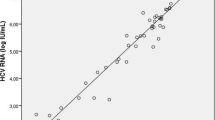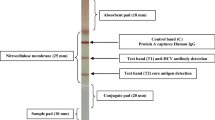Summary
Assay for the antibody to the c100 protein (anti-c100) lacks sensitivity in terms of detection of hepatitis C virus (HCV) in all samples. The author used anti-c100 and antibody to the GOR epitope (anti-GOR) by the enzyme-linked immunosorbent assay to examine 524 patients with chronic liver disease and 682 volunteer blood donors in Fukuoka, Japan. The prevalence of HCV infection, as revealed by the presence of anti-c100 and/or anti-GOR, was 3.9% in 540 volunteer blood donors, 12.7% in 142 volunteers with abnormal liver function, 7.4% in 135 patients with HBsAg-positive liver disease and 89.5% in 389 patrients with non-A, non-B (NANB) liver disease. These results show a higher prevalence than demonstrated only by the anti-c100 in NANB liver disease patients (82.5%, P< 0.01). The concurrence of anti-c100 and anti-GOR in subjects with HCV infection was 23.8% in 21 volunteer blood donors, 44.4% in 18 volunteers with abnormal liver function and 61.2% in 348 NANB liver disease patients. The concurrence seems to increase with deterioration of liver function. We concluded that combination assay for anti-c100 and anti-GOR demonstrated a more accurate prevalence of HCV infection than single assay for anti-c100 among NANB liver disease patients, and that the presence of anti-GOR plays a role in liver disease in anti-HCV-positive subjects.
Similar content being viewed by others
References
Choo QL, Kuo G, Weiner AJ, et al. Isolation of cDNA clone derived from a blood borne non-A, non-B viral hepatitis genenome. Science 1989;244:359–362.
Kuo G, Choo QL, Alter HJ, et al. An assay for circulating antibodies to a major etiologic virus of human non-A, non-B hepatits. Science 1989;244:362–364.
Esteban JI, Esteban R, Viladomiu L, et al. Hepatitis C virus antibodies among risk groups in Spain. Lancet 1989;2:294–297.
Van der Poel CL, Reesink HW, Lelie PN, et al. Anti-hepatitis C antibodies and non-A, non-B post-transfusion hepatitis in the Netherlands. Lancet 1989;2:297–298.
Bruix J, Barrera JM, Calvet X, et al. Prevalence of antibodies to hepatitis C virus in Spanish patients with hepatocellular carcinoma and hepatic cirrhosis. Lancet 1989;2:1004–1006.
Colombo M, Kuo G, Choo QL, et al. Prevalence of antibodies to hepatitis C virus in Italian patients with hepatocellular carcinoma. Lancet 1989;2:1006–1008.
Mishiro S, Hoshi Y, Takeda K, et al. Non-A, non-B hepatitis specific antibodies directed at host-derived epitope: implication for an autoimmune process. Lancet 1990;336:1400–1403.
International Group. Acute and chronic hepatitis revisited. Lancet 1977;2:914–919.
Kaplan PM, Greenman RL, Gerin JL, et al. DNA polymerase associated with human hepatitis B antigen. J Virol 1973;12:995–1005.
Glantz SA. Primer of biostatics. New York: McGraw-Hill Book Company, 1981;122–124.
Brown NB. Analysis of two-way tables, In: Dixon WJ, ed. Berkeley: University of California Press, 1990;256–276.
Kashiwagi S, Hayashi J, Ikematsu H, et al. An epidemiologic study of hepatitis B virus in Okinawa and Kyushu, Japan. Am J Epidemiol 1983;118:787–794.
Hayashi J, Hirata M, Noguchi A, et al. Hepatitis C virus is a more likely cause of chronic liver disease in the Japanese population than hepatitis B virus. Fukuoka Acta Med 1991;82:648–654.
Weiner AJ, Kuo G, Bradley DW, et al. Detection of hepatitis C viral sequences in non-A, non-B hepatitis. Lancet 1990;335:1–3.
Hayashi J, Kashiwagi S, Ikematsu H, et al. Sex- and-age-specific prevalences of HBeAg and anti-HBe among HBsAg carriers with or without liver function abnormalities in Okinawa, Japan. Microbiol Immunol 1988;32:843–850.
Author information
Authors and Affiliations
Rights and permissions
About this article
Cite this article
Hayashi, J., Nakashima, K., Hirata, M. et al. Hepatitis C virus detection is facilitated by the combined use of c100 protein and GOR epitope. Gastroenterol Jpn 27, 632–637 (1992). https://doi.org/10.1007/BF02774978
Received:
Accepted:
Issue Date:
DOI: https://doi.org/10.1007/BF02774978




